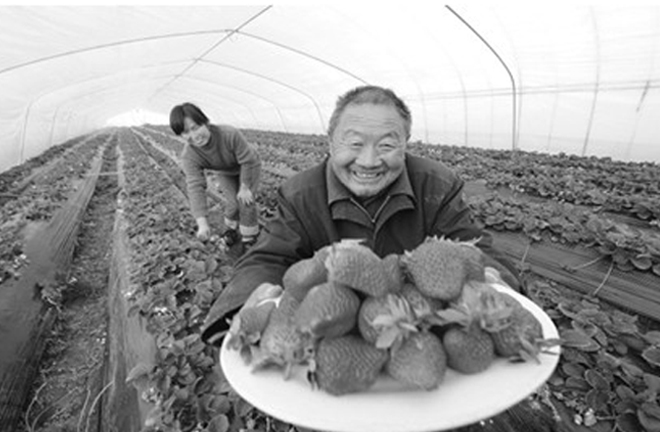Proper evaluations needed to push targeted poverty alleviation

China has taken targeted measures to alleviate poverty. The picture shows strawberry growers have a good harvest in Changfeng county, Anhui Province.
Targeted poverty alleviation, the basic strategy of reducing poverty in China, can be seen in the implementation of measures such as aid targets, project arrangements, the use of funds and aid measures. Recently, the symposium on “Targeted Poverty Alleviation and Evaluation from the Perspective of Social Divisions” was held at Central China Normal University in Wuhan, Hubei Province. Attending scholars offered suggestions for targeted poverty alleviation, using theories and methods of sociology.
Currently, the theoretical interpretation of targeted poverty alleviation mainly focuses on institutional analysis and implementation difficulties. An all-round analysis from a corresponding theoretical height is urgently needed on the operating mechanism of targeted poverty alleviation.
Li Bo, a scholar from the College of Humanities and Development Studies at China Agricultural University, demonstrated the system design, policies, operating methods and behavioral basis of targeted poverty alleviation from the “elaborate society” theoretical perspective. The theory of an elaborate society is abstract at the social level and derived from ideas of “intensive management” in the agricultural field and “delicacy management” in the management field.
Li proposed taking the following measures in the process of targetedpoverty alleviation. The system design could be transferred from “large and comprehensive” to “small and precise;” policy operations should be based on local logic; poverty alleviation practices should be “people-oriented;” and poverty alleviation governance should seek collaboration.
The theory of an “elaborate society” also emphasizes the effective link between different sectors and fields of production, management and social services, due to professionalism and the division of labor. To ensure the benign operation of the aforementioned governance system of targeted poverty alleviation, Li said, it is necessary to push forward the effective link between different departments and systems.
In addition to solidifying the theoretical basis of targeted poverty alleviation, scholars said that sociological evaluation is needed in any mode of poverty alleviation.
Huang Chengwei, deputy director of the International Poverty Reduction Center in China, said that targeted poverty alleviation aims to not only improve the economic income of every poor family or individual to reach a corresponding standard, but more importantly, make sure the new social situation they will face after alleviating poverty can be imbedded in a relatively steady and balanced social structure. For example, Huang added, finding ways to set the precise identification, assessment and exit mechanisms of the low-income population and surrounding people needs to involve social evaluations. Otherwise, new inequality is likely to occur inside the community, causing other social problems.
“So-called ‘poverty alleviation social evaluation’ means people use the theories and methods of anthropology, studies of project evaluation and applied sociology to analyze the social factors influencing poverty alleviation as well as all possible social problems in the implementation of poverty alleviation, through systematic investigation and collection of related population and different social and economic information and data. They then put forward the measures and schemes that will help expand positive social effects and decrease or avoid negative social influences to ensure the smooth implementation and sustainable realization of poverty alleviation,” said Shi Guoqing, a professor from the School of Public Administration at Hohai University in Nanjing, Jiangsu Province, adding that the involvement of social evaluation contributes not only to analyzing such elements as causes of poverty and poverty alleviation requirements of relevant groups, but also toward understanding mutual adaptation among these groups to ensure the sustainability of targeted poverty alleviation.
At present, the State Council Leading Group Office of Poverty Alleviation and Development is constructing a big data platform covering poverty alleviation and development nationwide, which is, in Huang’s view, the base and precondition of poverty alleviation.
Lu Hanwen, director of the Rural Governance and Poverty Reduction Center at Central China Normal University, said that information asymmetry in the poverty governance system is one of the reasons for problems such as poor people falling through the cracks and difficulty perceiving results in China’s poverty alleviation and development methods. It is an important way to construct the participatory “big data” platform of poverty alleviation and achieve shared information based on Internet technology, Lu said.
According to Lu’s explanation, this platform mainly includes file information on the impoverished population collected from the top down by the State Council Leading Group Office of Poverty Alleviation and Development, information from the National Bureau of Statistics and other sectors, and information on poverty alleviation projects organized by governments at all levels. In particular, information of poverty alleviation can be shared through Internet technology. Thus, all stakeholders in poverty alleviation and development can directly receive and feed back specific data on such aspects as poverty identification, project implementation and performance evaluation. Problems in such data can also be found in time through logic and statistical methods, and this can help avoid behaviors such as falsifying and manipulating information.
Hao Rihong is a reporter at the Chinese Social Sciences Today.
